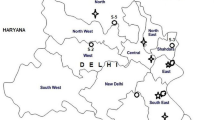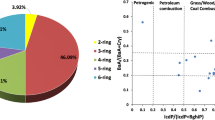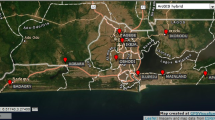Abstract
Polycyclic aromatic hydrocarbons (PAHs) are common contaminants in soil at former industrial areas; and in Sweden, some of the most contaminated sites are being remediated. Generic guideline values for soil use after so-called successful remediation actions of PAH-contaminated soil are based on the 16 EPA priority pollutants, which only constitute a small part of the complex cocktail of toxicants in many contaminated soils. The aim of the study was to elucidate if the actual toxicological risks of soil samples from successful remediation projects could be reflected by chemical determination of these PAHs. We compared chemical analysis (GC-MS) and bioassay analysis (H4IIE-luc) of a number of remediated PAH-contaminated soils. The H4IIE-luc bioassay is an aryl hydrocarbon (Ah) receptor-based assay that detects compounds that activate the Ah receptor, one important mechanism for PAH toxicity. Comparison of the results showed that the bioassay-determined toxicity in the remediated soil samples could only be explained to a minor extent by the concentrations of the 16 priority PAHs. The current risk assessment method for PAH-contaminated soil in use in Sweden along with other countries, based on chemical analysis of selected PAHs, is missing toxicologically relevant PAHs and other similar substances. It is therefore reasonable to include bioassays in risk assessment and in the classification of remediated PAH-contaminated soils. This could minimise environmental and human health risks and enable greater safety in subsequent reuse of remediated soils.


Similar content being viewed by others
References
Alexander M (2000) Aeging, bioavailability and overestimation of risk from environmental pollutants. Environ Sci Technol 34:4259–4265
Alexander RR, Alexander M (2000) Bioavailability of genotoxic compounds in soils. Environ Sci Technol 34:1589–1593. doi:10.1021/es991120d
Andersson E, Rotander A, von Kronhelm T, Berggren A, Ivarsson P, Hollert H, Engwall M (2009) AhR agonist and genotoxicant bioavailability in a PAH-contaminated soil undergoing biological treatment. Environ Sci Pollut R 16:521–530. doi:10.1007/s11356-009-0121-9
Atagana HI, Haynes RJ, Wallis FM (2003) The use of surfactants as possible enhancers in bioremediation of creosote contaminated soil. Water Air Soil Pollut 142:137–149
Bamforth SM, Singleton I (2005) Bioremediation of polycyclic aromatic hydrocarbons: current knowledge and future directions. J Chem Technol Biot 80:723–736
Behnisch PA, Hosoe K, Sakai SI (2003) Brominated dioxin-like compounds: in vitro assessment in comparison to classical dioxin-like compounds and other polyaromatic compounds. Environ Int 29:861–877
Bekki K, Takigami H, Suzuki G, Tang N, Hayakawa K (2009) Evaluation of toxic activities of polycyclic aromatic hydrocarbon derivatives using in vitro bioassays. J Healt Sci 55:601–610
Bergknut M, Frech K, Andersson PL, Haglund P, Tysklind M (2006) Characterisation and classification of complex PAH samples using GC-qMS and GC-TOFMS. Chemosphere 65:2208–2215. doi:10.1016/j.chemosphere.2006.05.050
CCME (2010) Canadian soil quality guidelines for the protection of environmental and human health: Carcinogenic and Other PAHs. Canadian environmental quality guidelines, 1999, Canadian Council of Ministers of the Environment, Winnipeg
Chu W, Kwan CY (2003) Remediation of contaminated soil by a solvent/surfactant system. Chemosphere 53:9–15
Chung N, Alexander M (2002) Effect of soil properties on bioavailability and extractability of phenanthrene and atrazine sequestered in soil. Chemosphere 48:109–115. doi:10.1016/s0045-6535(02)00045-0
Dalgren KE, Düker A, Arwidsson Z, von Kronhelm T, van Hees PAW (2011) Recycling of remediated soil—evaluation of leaching tests as tools for characterisation. Waste Manage 31:215–224. doi:10.1016/j.wasman.2009.12.021
Denison MS, Pandini A, Nagy SR, Baldwin EP, Bonati L (2002) Ligand binding and activation of the Ah receptor. Chem Biol Interact 141:3–24
Elgh-Dalgren K, Arwidsson Z, Camdzija A, Sjöberg R, Ribé V, Waara S, Allard B, von Kronhelm T, van Hees PAW (2009) Laboratory and pilot scale soil washing of PAH and arsenic from a wood preservation site: changes in concentration and toxicity. J Hazard Mater 172:1033–1040
Enell A, Reichenberg F, Warfvinge P, Ewald G (2004) A column method for determination of leaching of polycyclic aromatic hydrocarbons from aged contaminated soil. Chemosphere 54:707–715
Fent K, Bätscher R (2000) Cytochrome P4501A induction potencies of polycyclic aromatic hydrocarbons in a fish hepatoma cell line: demonstration of additive interactions. Environ Toxicol Chem 19:2047–2058. doi:10.1002/etc.5620190813
Hinger G, Brinkmann M, Bluhm K, Sagner A, Takner H, Eisenträger A, Braunbeck T, Engwall M, Tiehm A, Hollert H (2011) Some heterocyclic aromatic compounds are Ah receptor agonists in the DR-CALUX assay and the EROD assay with RTL-W1 cells. Environ Sci Pollut R 18:1297–1304. doi:10.1007/s11356-011-0483-7
ISO/DIS 21268–2, Soil quality - Leaching procedures for subsequent chemical and ecotoxological testing of soil and soil materials - Part 2: Batch test using a liquid to solid ratio of 10 l/kg dry matter
Jung DKJ, Klaus T, Fent K (2001) Cytochrome P450 induction by nitrated polycyclic aromatic hydrocarbons, azaarenes and binary mixtures in fish hepatoma cell line PLHC-1. Environ Toxicol Chem 20:149–159. doi:10.1002/etc.5620200117
Keiter S, Grund S, van Bavel B, Hagberg J, Engwall M, Kammann U, Klempt M, Manz W, Olsman H, Braunbeck T, Hollert H (2008) Activities and identification of aryl hydrocarbon receptor agonists in sediments from the Danube river. Anal Bioanal Chem 390:2009–2019. doi:10.1007/s00216-007-1652-x
Kelsey JW, Kottler BD, Alexander M (1996) Selective chemical extractants to predict bioavailability of soil-aged organic chemicals. Environ Sci Technol 31:214–217. doi:10.1021/es960354j
Larsson M, Orbe D, Engwall M (2012) Exposure time-dependent effects on the relative potencies and additivity of PAHs in the Ah receptor-based H4IIE-luc bioassay. Environ Toxicol Chem 31:1149–1157. doi:10.1002/etc.1776
Liste HH, Alexander M (2002) Butanol extraction to predict bioavailability of PAHs in soil. Chemosphere 46:1011–1017
Lundstedt S, Haglund P, Oberg L (2003) Degradation and formation of polycyclic aromatic compounds during bioslurry treatment of an aged gasworks soil. Environ Toxicol Chem 22:1413–1420
Lundstedt S, White PA, Lemieux CL, Lynes KD, Lambert IB, Öberg L, Haglund P, Tysklind M (2007) Sources, fate and toxic hazards of oxygenated polycyclic aromatic hydrocarbons (PAHs) at PAH-contaminated sites. Ambio 36:475–485
Machala M, Vondracek J, Blaha L, Ciganek M, Neca J (2001) Aryl hydrocarbon receptor-mediated activity of mutagenic polycyclic aromatic hydrocarbons determined using in vitro reporter gene assay. Mutat Res 497:49–62
Marlowe JL, Puga A (2005) Aryl hydrocarbon receptor, cell cycle regulation, toxicity and tumorigenesis. J Cell Biochem 96:1174–1184. doi:10.1002/jcb.20656
Murk AJ, Legler J, Denison MS, Giesy JP, Van De Guchte C, Brouwer A (1996) Chemical-activated luciferase gene expression (CALUX): a novel in vitro bioassay for Ah receptor active compounds in sediments and pore water. Fund Appl Toxicol 33:149–160
Musa Bandowe BA, Shukurov N, Kersten M, Wilcke W (2010) Polycyclic aromatic hydrocarbons (PAHs) and their oxygen-containing derivatives (OPAHs) in soils from the Angren industrial area, Uzbekistan. Environ Pollut 158:2888–2899. doi:10.1016/j.envpol.2010.06.012
Nestler FHM (1974) Characterization of wood-preserving coal-tar creosote by gas–liquid chromatography. Anal Chem 46:46–53. doi:10.1021/ac60337a008
Niederer M (1998) Determination of polycyclic aromatic hydrocarbons and substitutes (Nitro-, Oxy-PAHs) in urban soil and airborne particulate by GC-MS and NCI-MS/MS. Environ Sci Pollut R 5:209–216. doi:10.1007/bf02986403
Okey AB, Riddick DS, Harper PA (1994) The Ah receptor: mediator of the toxicity of 2,3,7,8-tetrachlorodibenzo-p-dioxin (TCDD) and related compounds. Toxicol Lett 70:1–22
Ong R, Lundstedt S, Haglund P, Marriott P (2003) Pressurised liquid extraction-comprehensive two-dimensional gas chromatography for fast-screening of polycyclic aromatic hydrocarbons in soil. J Chromatogr A 1019:221–232. doi:10.1016/j.chroma.2003.07.006
Richter BE, Jones BA, Ezzell JL, Porter NL, Avdalovic N, Pohl C (1996) Accelerated solvent extraction: a technique for sample preparation. Anal Chem 68:1033–1039. doi:10.1021/ac9508199
RIVM (2012) Environmental risk limits for polycyclic aromatic hydrocarbons (PAHs): for direct aquatic, benthic, and terrestrial toxicity. RIVM report 607711007
S-EPA (2009) Riktvärden för förorenad mark -Modellbeskrivning och vägledning. Naturvårdserkets rapport 5976 (in Swedish)
Šídlová T, Novák J, Janošek J, Anděl P, Giesy JP, Hilscherová K (2009) Dioxin-like and endocrine disruptive activity of traffic-contaminated soil samples. Arch Environ Con Tox 57:639–650. doi:10.1007/s00244-009-9345-4
Tang J, Alexander M (1999) Mild extractability and bioavailability of polycyclic aromatic hydrocarbons in soil. Environ Toxicol Chem 18:2711–2714. doi:10.1002/etc.5620181209
US-EPA (1996) Soil Screening Guidance: User’s Guide. EPA Document Number: EPA540/R-96/018. July 1996
US-EPA (2007) Ecological Soil Screening Levels for Polycyclic Aromatic Hydrocarbons (PAHs) Interim Final. OSWER Directive 9285.7-78
Villeneuve DL, Blankenship AL, Giesy JP (2000) Derivation and application of relative potency estimates based on in vitro bioassay results. Environ Toxicol Chem 19:2835–2843. doi:10.1002/etc.5620191131
Villeneuve DL, Khim JS, Kannan K, Giesy JP (2002) Relative potencies of individual polycyclic aromatic hydrocarbons to induce dioxin like and estrogenic responses in three cell lines. Environ Toxicol 17:128–137
Willett KL, Gardinali PR, Sericano JL, Wade TL, Safe SH (1997) Characterisation of the H4IIE rat hepatoma cell bioassay for evaluation of environmental samples containing polynuclear aromatic hydrocarbons (PAHs). Arch Environ Contam Toxicol 32:442–448
Yuan T, Marshall WD (2007) Optimising a washing procedure to mobilise polycyclic aromatic hydrocarbons (PAHs) from a field-contaminated soil. Ind Eng Chem Res 46:4626–4632
Acknowledgment
Financial support was granted by the Swedish Environmental Protection Agency.
Professor John Giesy, University of Saskatechewan is acknowledged for providing the H4IIE-luc cells.
Author information
Authors and Affiliations
Corresponding author
Additional information
Responsible editor: Zhihong Xu
Rights and permissions
About this article
Cite this article
Larsson, M., Hagberg, J., Rotander, A. et al. Chemical and bioanalytical characterisation of PAHs in risk assessment of remediated PAH-contaminated soils. Environ Sci Pollut Res 20, 8511–8520 (2013). https://doi.org/10.1007/s11356-013-1787-6
Received:
Accepted:
Published:
Issue Date:
DOI: https://doi.org/10.1007/s11356-013-1787-6




